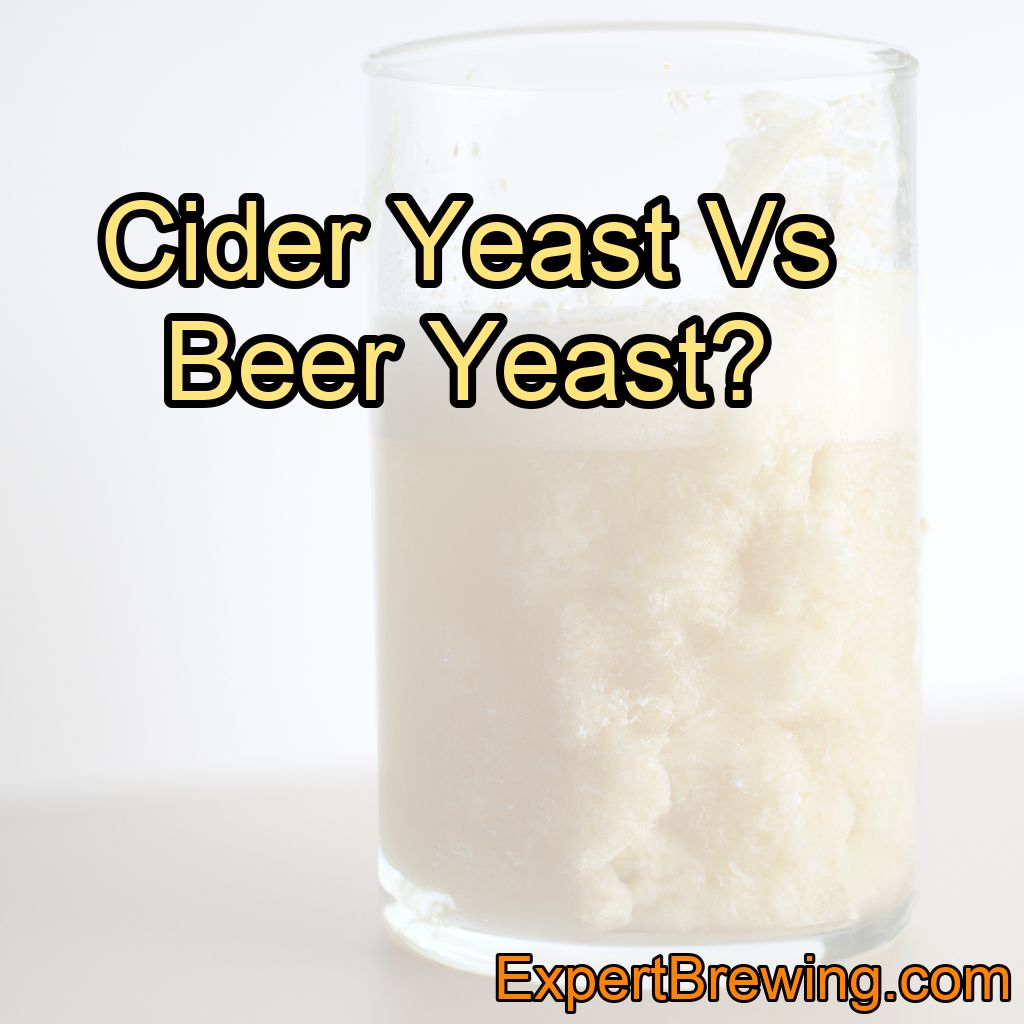Cider and beer are two of the most popular alcoholic beverages around the world. While both are fermented, they have distinct differences in flavor, ingredients, and production methods. One key distinction that sets these two beverages apart is the yeast used during fermentation. In this blog post, we will explore the differences between cider yeast and beer yeast, their impact on the final product, and how brewers can choose the best yeast for their fermentation needs.
Cider yeast and beer yeast are two different types of yeast used in the fermentation of their respective beverages. While there are some similarities between the two, they have unique characteristics that affect the flavor, aroma, and mouthfeel of the final product.
The Basics of Yeast and Fermentation
Yeast is a single-celled microorganism that is essential for the fermentation process in both cider and beer production. It consumes the sugar found in fruit juice or malted grains, converting it into alcohol and carbon dioxide. This process is what gives alcoholic beverages their characteristic flavors, aromas, and textures.
In general, there are two main types of yeast used in alcoholic beverage production: Saccharomyces cerevisiae and Saccharomyces uvarum (also known as Saccharomyces pastorianus or Saccharomyces carlsbergensis). Both of these yeast strains can be used for cider and beer fermentation, but they have different properties that can affect the final product.
Cider Yeast Characteristics
Cider yeast is typically a strain of Saccharomyces cerevisiae that has been specifically selected for its ability to ferment fruit sugars. These yeast strains are often chosen for their ability to handle high sugar concentrations, low pH levels, and a variety of fermentation temperatures. Some common cider yeast strains include:
- Safcider: A versatile yeast that can ferment a wide range of fruit juices and ciders, producing a clean, fruity aroma.
- Cider House Select: A high-performing yeast that is ideal for a variety of cider styles, producing a complex and well-rounded flavor profile.
- Wyeast 4766 Cider: A popular choice for many cidermakers, this strain ferments cleanly and quickly, producing a crisp, clean cider with a hint of fruity esters.
Beer Yeast Characteristics
Beer yeast, on the other hand, is usually a strain of either Saccharomyces cerevisiae (ale yeast) or Saccharomyces uvarum (lager yeast). These strains are selected for their ability to ferment maltose, the primary sugar found in malted grains. They also have specific temperature requirements and produce different flavor profiles depending on the strain. Some common beer yeast strains include:
- Safale US-05: A popular ale yeast that ferments cleanly and quickly, producing a well-balanced beer with low ester production.
- Wyeast 2124 Bohemian Lager: A versatile lager yeast strain that produces clean, crisp beers with a subtle malt character.
- White Labs WLP002 English Ale: A highly flocculent yeast that produces a rich, malty beer with a fruity ester profile.
How Yeast Selection Impacts Flavor and Aroma
The yeast strain used during fermentation has a significant impact on the flavor and aroma of the final product. In addition to converting sugars into alcohol and carbon dioxide, yeast also produces various byproducts, such as esters, phenols, and higher alcohols. These compounds contribute to the unique flavor and aroma profiles of different cider and beer styles.
Cider yeast strains tend to produce more fruity esters, which can enhance the natural fruit flavors in the cider. Beer yeast strains, especially ale yeast strains, can also produce fruity esters, but they typically have a more complex flavor profile, with a balance of malt, hops, and yeast-derived flavors.
Mouthfeel and Texture Differences
The yeast strain used in fermentation can also affect the mouthfeel and texture of the final product. For example, some yeast strains are highly flocculent, meaning they clump together and settle out of the liquid more quickly. This can result in a clearer, more stable final product with a smoother mouthfeel.
Cider yeast strains tend to be less flocculent than beer yeast strains, which can result in a cloudier final product with a slightly more viscous texture. However, many cidermakers believe that this contributes to the overall complexity and character of the cider.
Fermentation Temperature Requirements
One key difference between cider yeast and beer yeast is their fermentation temperature requirements. Cider yeast strains are generally more tolerant of a wide range of temperatures, with some strains able to ferment effectively at temperatures as low as 45°F (7°C) or as high as 85°F (29°C).
Beer yeast strains, on the other hand, have more specific temperature requirements. Ale yeast strains typically ferment best at warmer temperatures, between 60°F (15°C) and 75°F (24°C), while lager yeast strains require cooler temperatures, between 45°F (7°C) and 55°F (13°C).
hoosing the Right Yeast for Your Fermentation Needs
When selecting a yeast strain for your cider or beer fermentation, consider the following factors:
- The desired flavor and aroma profile of the final product
- The sugar content and pH of the juice or wort
- The fermentation temperature range you can maintain
Experimenting with different yeast strains can help you find the perfect match for your fermentation needs and create a truly unique and delicious final product.
Can You Use Beer Yeast for Cider and Vice Versa?
While it is generally recommended to use yeast strains specifically designed for cider or beer fermentation, it is possible to use beer yeast for cider and vice versa. Some brewers and cidermakers have had success experimenting with different yeast strains to create unique flavor profiles and styles.
However, keep in mind that using a yeast strain outside of its intended purpose may result in unexpected flavors, aromas, or fermentation issues. It’s important to monitor the fermentation closely and be prepared to make adjustments if necessary.
The Importance of Proper Yeast Handling and Storage
Regardless of whether you are using cider yeast or beer yeast, it is crucial to handle and store your yeast properly to ensure optimal fermentation performance. This includes:
- Storing yeast in a cool, dark place (such as a refrigerator)
- Rehydrating dry yeast according to the manufacturer’s instructions
- Ensuring proper sanitation throughout the brewing process to prevent contamination
Conclusion:
In summary, cider yeast and beer yeast are two distinct types of yeast used in the fermentation of their respective beverages. Although there are some similarities between the two, they have unique characteristics that influence the flavor, aroma, and mouthfeel of the final product. When choosing a yeast strain for your fermentation needs, consider factors such as desired flavor profile, sugar content, and temperature requirements. By experimenting with different yeast strains and handling them properly, brewers and cidermakers can create a wide range of delicious and unique beverages.
- Facts About Cider Yeast and Beer Yeast:
1. Yeast is a single-celled microorganism essential for the fermentation process.
2. There are two main types of yeast used in alcoholic beverage production: Saccharomyces cerevisiae and Saccharomyces uvarum.
3. Cider yeast strains are typically selected for their ability to ferment fruit sugars.
4. Beer yeast strains are selected for their ability to ferment maltose, the primary sugar found in malted grains.
5. Yeast selection impacts the flavor, aroma, and mouthfeel of the final product.
6. Cider yeast strains tend to produce more fruity esters, while beer yeast strains produce a more complex flavor profile.
7. Fermentation temperature requirements vary between cider yeast and beer yeast strains.
8. It is possible to use beer yeast for cider and vice versa, but it may result in unexpected flavors or fermentation issues.
9. Proper yeast handling and storage are crucial for optimal fermentation performance.
10. Experimenting with different yeast strains can help create unique and delicious final products.
FAQs
Can I use beer yeast for cider?
While beer yeast can technically be used to ferment cider, it is not recommended as it may not produce the desired flavor profile and may result in off-flavors. It is best to use a yeast strain specifically designed for cider fermentation.
Is cider yeast the same as wine yeast?
No, cider yeast and wine yeast are not the same. While they both belong to the Saccharomyces family of yeasts, they have different strains that are better suited for different types of fermentation. Cider yeast strains are better at fermenting apple juice and producing a crisp, dry cider, while wine yeast strains are better at fermenting grape juice and producing a complex wine with specific flavors and aromas.
Can you use wine or beer yeast for cider?
Yes, wine or beer yeast can be used for cider, but it is recommended to use a cider-specific yeast for best results.
Does cider contain brewers yeast?
Yes, cider can contain brewers yeast as it is a natural byproduct of the fermentation process used to make cider.
What is the best wine yeast for cider?
The best wine yeast for cider is a matter of personal preference, as different yeast strains can produce different flavors and aromas. Some popular options include Champagne yeast, cider yeast, and white wine yeast. It is recommended to experiment with different yeast strains to find the one that best suits your taste preferences.
Does apple cider contain yeast?
Yes, apple cider contains yeast. Yeast is a natural component of apples and is necessary for the fermentation process that turns apple juice into cider.




